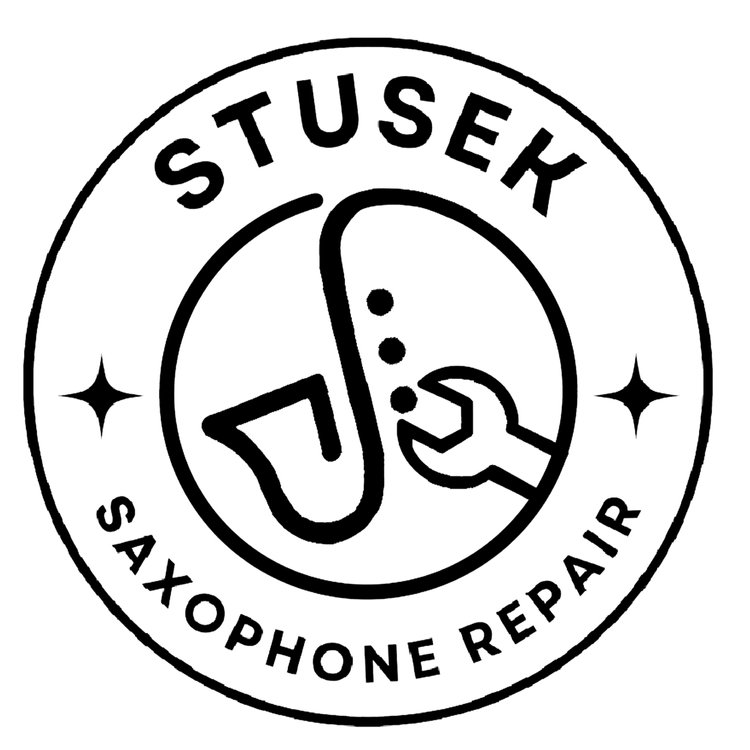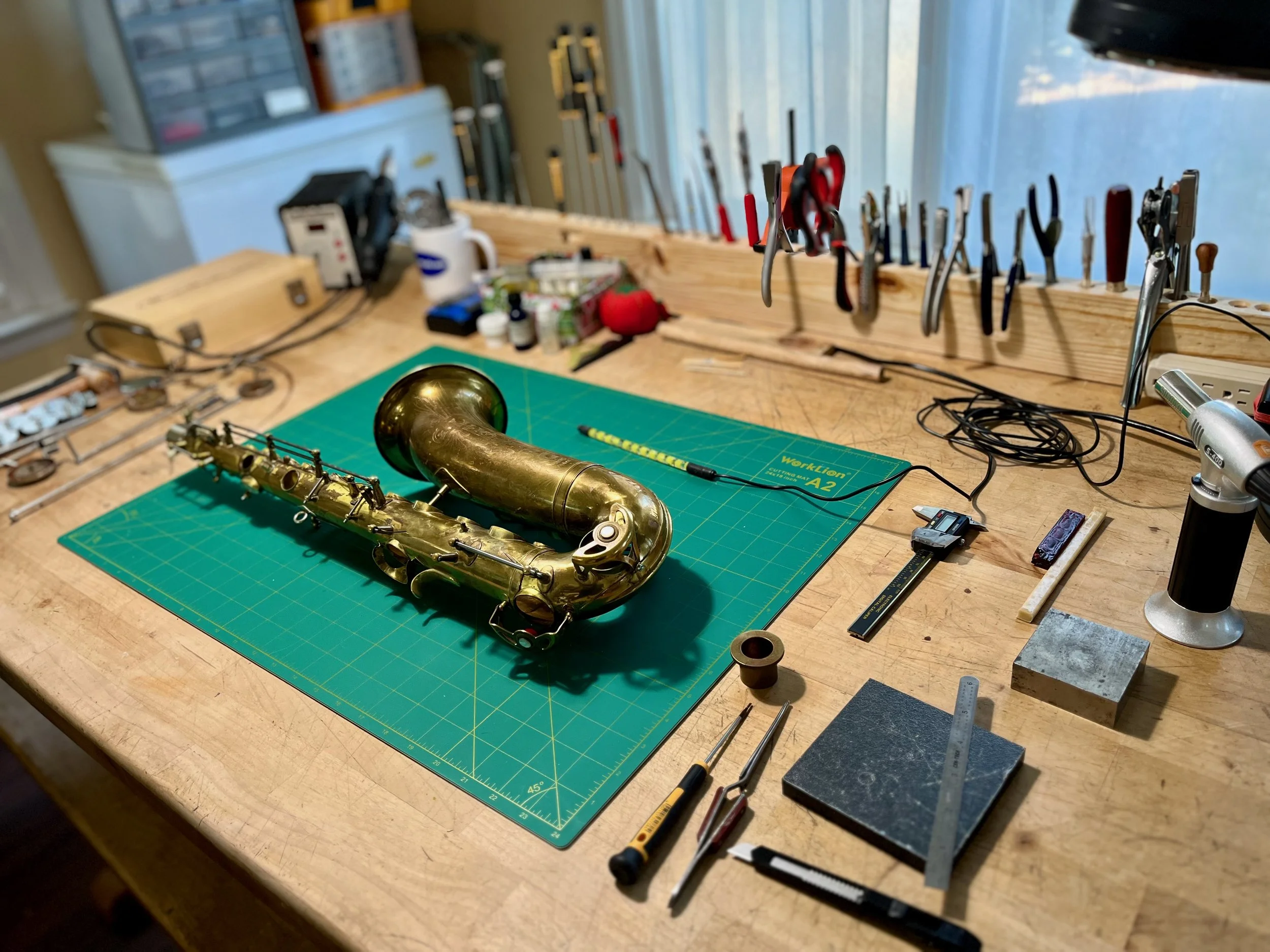repair services
Estimates and Service quotes
PC (Play Condition) Emergency Repairs and Adjustments (by appointment)
COA (Clean, Oil, Adjust)
“New” horn set-up
Mechanical silencing
Instrument overhaul
How approach saxophone repair
Estimates and Services quotes (click here to begin a quote)
"How much will it cost to fix my saxophone?"—it's the question I hear most often. And my honest answer? I don’t know until I see the instrument. Every saxophone is unique, with different needs and varying levels of required attention.
To give you an idea, my current rate is $60 per hour. If you stop by my shop and your adjustment takes less than 30 minutes, I probably won’t charge you at all—it’s just good business, and I enjoy meeting fellow musicians and helping where I can. For more complex repairs, I’ll provide a free quote on the spot, including an estimated timeframe and the number of hours involved.
All repairs come with an invoice and a six-month absolute guarantee. Your invoice will also include a list of recommended upgrades with pricing, should you be interested—though these are typically separate from the original repair. Many times, achieving the best results requires a combination of services, and I always strive to deliver more than what’s promised.
PC (Play Condition); Emergency Repairs and Adjustments (by appointment)
I know the panic of an upcoming concert when something suddenly goes wrong with your saxophone—whether it’s a broken spring, a fallen pad, or low notes that stop responding just before a big performance. As a working musician myself, I understand the urgency and will do everything I can to get you back up and playing as quickly as possible. I’ll also offer advice on long-term solutions to prevent future issues. And if that means working outside regular hours, I’m happy to do so.
COA (Clean, Oil, Adjust)
A COA (Clean, Oil, and Adjust) is like routine maintenance for your car—it should be done regularly to keep your saxophone in top shape and prevent deterioration. I recommend scheduling a COA every two years or as needed.
During the process, your horn is fully disassembled, cleaned, and stripped of old oil and lubricants, which are then replaced. It's reassembled, and any leaks or mechanical noises are addressed. If your saxophone is relatively clean and in good condition, this typically takes 3-4 hours. If it needs more attention, expect 5-6 hours.
For older instruments, a COA is often just the first step, leading to key fitting, new pads, and replacing touch materials like cork, felt, and Teflon. Pricing generally ranges from $200-$400, depending on the condition of the horn.
“New” horn set-up
New-horn set-up can be as simple as giving an instrument a once over to mechanical silencing, adjusting key heights and spring tension, addressing tuning, and removing leaks that your seller didn’t address or that developed after a few hours of playing. Some instruments come from the factory nearly perfect, while other manufacturers are somewhat less diligent in this respect. Stop by for a free evaluation and a chat on the possibilities for your saxophone.
Mechanical Silencing
Professional musicians demand the highest standards from their saxophones, including a perfectly functioning and completely silent mechanism. Even top-tier, brand-new saxophones can benefit from this service.
In most cases, all touch materials are upgraded—often replacing a single material with a combination of two for improved performance. Teflon and high-tech materials are added wherever keys need to glide smoothly against each other, such as the left-hand table keys. Lost motion is eliminated, and any pads that have hardened or become brittle are replaced.
Since thorough cleaning and oiling are essential for silencing an instrument, this service is only available as an add-on to a COA. The process typically takes 4-5 hours, with pricing ranging from $200-$500, depending on the instrument's condition.
An Example
A good friend and professional saxophonist recently brought in his well-loved alto saxophone—an instrument he plays constantly in all kinds of conditions. It’s a true workhorse. Over time, it had developed mechanical noise, significant leaks, and a buildup of dirt and surface corrosion. It hadn’t been properly serviced in years.
Although the pads were still functional (with some set to be replaced soon), the horn needed extensive key fitting, a deep cleaning, and a full replacement of all corks and felts with upgraded materials. After about 13 hours of work, this saxophone was back in top shape—quieter and playing better than the day he bought it. The total cost? $800 in labor + $50 in materials. More importantly, he’s thrilled with how it plays.
This is a great example of why investing in a professional instrument is worth it. My friend knows and loves his saxophone—it responds the way he expects, and with proper care, it will last a lifetime (or longer—I regularly service saxophones over 100 years old that are still going strong).
Compare that to a $300 saxophone from Amazon. While it might work for a casual beach gig, these instruments break down quickly, are harder and more expensive to repair, and often cost more to fix than replace. That cycle isn’t sustainable—for musicians or for the planet. Something to think about.
Instrument overhaul
This includes a version of the COA and Mechanical Silencing, but also includes new pads, all lost motion in the keyword is removed, and possibly springs replaced and spring tension balanced. You can expect your horn to have a silent mechanism that seals perfectly. This work is unconditionally guaranteed for two years. $1600-$2500.
How I approach saxophone repair
You might not think there are many approaches to saxophone repair, but there are. When considering an overhaul or repair, it’s important to ask: What’s your goal?
Do you want to restore your saxophone to its original condition?
Do you prefer using original (or as close to original as possible) materials?
Would you like firmer or softer pads?
Does the instrument need to look brand new? (This can be done but may lower its value.)
Do you want your saxophone to play even better than when it was new? (This can be achieved with modern materials and modifications.)
My first priority is to do no harm—nothing will be altered in a way that permanently changes how your instrument functions without your approval. As a professional saxophonist, I have strong opinions on setup (key height, spring tension, key placement, etc.), but I won’t impose my preferences on your horn without a thoughtful discussion. If you love how your instrument feels, that won’t change unless you want it to.
Ultimately, your saxophone needs to meet both my standards and yours. Whenever possible, I like to work together at the end of the repair process—so if you pick up your instrument in person, we’ll fine-tune it together to make sure it plays exactly how you want. This extra time is built into the cost of your repair. Let’s just call it the Happiness Clause on your invoice.
What I don’t offer
Re-padding
Some repair shops will offer a re-pad option in their service lists. I don’t offer this because I feel that without the COA and Mechanical Silencing I can’t achieve what I expect from my own saxophones, and I simply wouldn’t feel comfortable letting instruments out of my shop knowing they are going to need more work soon, work that I couldn’t guarantee.
Engraving
This is simply outside of my abilities. But I know just where to send you for this service!
Re-plating or re-lacquering
Although I can do “spot” versions of these, I don’t have the materials and tools to do either of these things on an entire instrument. But again, I can refer you to shops across the country that can handle something like this.






